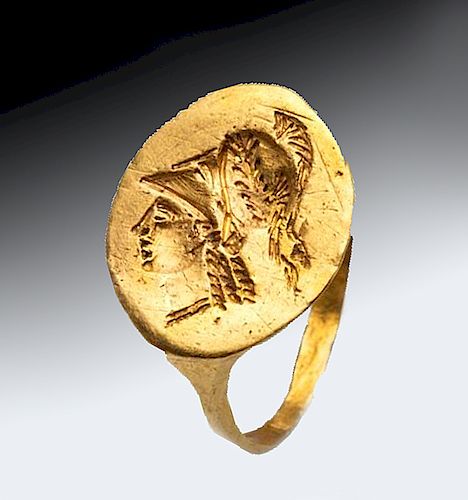Greek / Pontic Gold Signet Ring w/ Head of Athena
Lot 29b
About Seller
Artemis Fine Arts
686 S Taylor Ave, Ste 106
Louisville, CO 80027
United States
Selling antiquities, ancient and ethnographic art online since 1993, Artemis Gallery specializes in Classical Antiquities (Egyptian, Greek, Roman, Near Eastern), Asian, Pre-Columbian, African / Tribal / Oceanographic art. Our extensive inventory includes pottery, stone, metal, wood, glass and textil...Read more
Estimate:
$8,500 - $12,000
Absentee vs Live bid
Two ways to bid:
- Leave a max absentee bid and the platform will bid on your behalf up to your maximum bid during the live auction.
- Bid live during the auction and your bids will be submitted real-time to the auctioneer.
Bid Increments
| Price | Bid Increment |
|---|---|
| $0 | $25 |
| $300 | $50 |
| $1,000 | $100 |
| $2,000 | $250 |
| $5,000 | $500 |
| $10,000 | $1,000 |
| $20,000 | $2,500 |
| $50,000 | $5,000 |
| $100,000 | $10,000 |
| $200,000 | $20,000 |
About Auction
By Artemis Fine Arts
Sep 26, 2019
Set Reminder
2019-09-26 10:00:00
2019-09-26 10:00:00
America/New_York
Bidsquare
Bidsquare : Exceptional Day 1: Antiquities & Asian Art
https://www.bidsquare.com/auctions/artemis-gallery/exceptional-day-1-antiquities-asian-art-4437
Day 1 of an important 2-day auction featuring exceptional, museum-worthy examples of Egyptian, Greek, Etruscan, Roman, Viking, Russian, Near Eastern, as well as Asian Art from China, Japan, Thailand, Vietnam, Burma and India. Artemis Fine Arts info@artemisfinearts.com
Day 1 of an important 2-day auction featuring exceptional, museum-worthy examples of Egyptian, Greek, Etruscan, Roman, Viking, Russian, Near Eastern, as well as Asian Art from China, Japan, Thailand, Vietnam, Burma and India. Artemis Fine Arts info@artemisfinearts.com
- Lot Description
Greek, probably East Greek or Pontic, ca. 4th century BCE. A dazzling gold ring depicting a profile head of a helmeted Athena, made from a single piece of gold that was skillfully hammered into its shape comprised of a narrow hoop and an expanded oval bezel and finely engraved. The bezel presents the goddess facing the viewer's left and wearing her trademark Corinthian helmet pulled upon the top of her head with the lower front designed to cover her chin - similar to depictions of Athena on Greek coins that date to the later 4th century BCE. Interestingly, these coins typically show Athena facing the viewer's right. Given that this image faces the opposite direction, we believe this ring was used as a signet. Size: .878" H (2.23 cm)
This ring was analyzed by Striptwist Ltd, London and will be accompanied by the Striptwist report written by Dr. Jack Ogden. The report states that, "the form and manufacture of the ring are as expected for a ring dating to about the fourth century BC. The engraved design was cut using a shallow profile engraving tool as noted don other ancient gold rings of the period." It also states, "Rings of this type required considerable skill to produce, particularly here where it is so delicately proportioned." Furthermore, "The gold of the ring was not analysed, but it has a slightly lemon-yellow colour that indicates that it is relatively high purity gold, with a small and probably deliberate silver content. The origin of the ring probably cannot be localised within the Greek sphere of influence, which extended right round the Eastern half of the Mediterranean, from Italy to parts of North Africa; up through the Black Sea, and East to the Persian Empire. However, the weight at 5.4 grams might suggest an east Greek or Pontic origin as this may relate to a weight unit of 5.4 grams long traditional in the East and through the Persian Empire. In the undersignedÂ’s experience the gold composition, as indicated by colour, might also point to an eastern origin, rather than one within Greece itself."
Provenance: ex-Madame Frances Artuner collection, Belgium, 1960sExpected age wear with minor scuffs and minute nicks but the form and imagery are well preserved.Condition
- Shipping Info
-
All shipping is handled in-house for your convenience. Your invoice from Artemis Gallery will include shipping calculation instructions. If in doubt, please inquire BEFORE bidding for estimated shipping costs for individual items.
-
- Buyer's Premium



 EUR
EUR CAD
CAD AUD
AUD GBP
GBP MXN
MXN HKD
HKD CNY
CNY MYR
MYR SEK
SEK SGD
SGD CHF
CHF THB
THB




